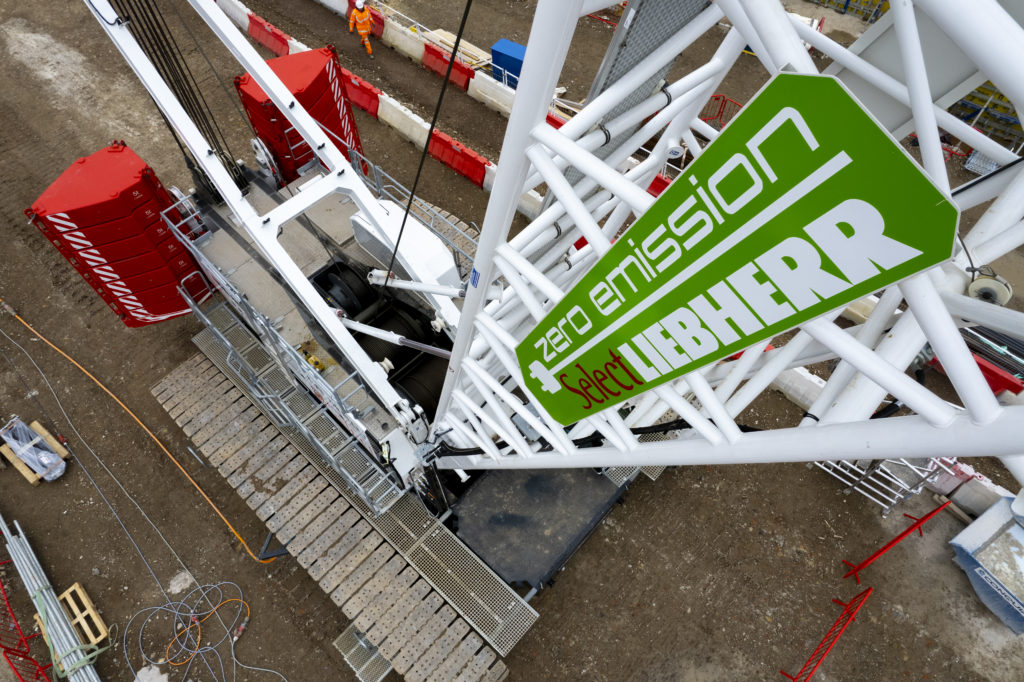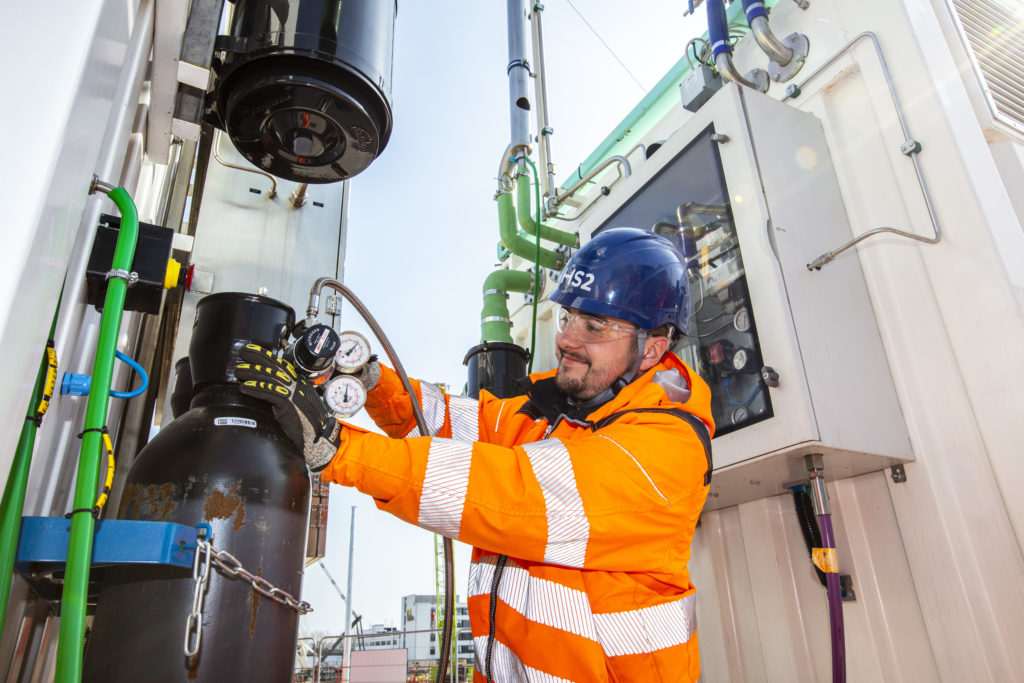HS2’s Net Zero Carbon Plan, published in January, set out how the project will achieve new carbon reduction milestones, support the decarbonisation of the UK construction sector, and reduce the carbon footprint of its programme. As Europe’s largest infrastructure project, HS2 says it is “acutely aware” of its responsibilities and is “committed to playing our part in the collective endeavour to combat the climate emergency.”
Aiming to achieve net zero carbon from 2035, and with a target of achieving diesel-free construction sites by 2029, HS2 is collaborating with the industry and its supply chain to accelerate innovation in low carbon technologies, such as fully electric machinery, alternative fuels, and renewable energy solutions.
Low carbon cranes
Back in February, HS2 announced a step forward in its move towards this goal when it announced the arrival of three fully electric crawler cranes at its sites in London. This followed the UK’s first trial of an electric crawler crane at HS2’s Curzon Street Station site in Birmingham in 2021.
With only five of these 100% emissions-free, giant Liebherr cranes in the world, three are currently in use by HS2, helping to cut carbon, improve air quality and reduce noise, and make sites cleaner and safer for site workers and local communities.
Expanded – a Laing O’Rourke specialist business working for Balfour Beatty, VINCI SYSTRA joint venture (BBVS) – took two of the giant battery-powered electric crawler cranes onto HS2’s Old Oak Common Station site in West London. The Liebherr LR1250E, a 250-tonne lattice jib crawler crane, and the 160-tonne Liebherr LR1160E both operate emission-free and are being used to construct the 850-metre-long Old Oak Common Station box which will house six high-speed rail platforms. The third crane – a 160 tonne Liebherr LR1160E, was delivered to HS2’s Canterbury Road vent shaft site managed by Skanska Costain STRABAG joint venture (SCS JV).

At the time of their arrival, HS2 Minister, Andrew Stephenson said: “Having the UK’s first fully electric crawler cranes begin work on HS2 is the latest step in making these commitments a reality and aligning the country’s biggest infrastructure project with the Government’s ambitions for a greener transport.”
Diesel-free construction
In a further positive step, in May, the Canterbury Road vent shaft site was named HS2’s first diesel-free site. Along with the LR1160E crane, SCS JV has introduced a range of diesel-free technologies and greener equipment to the site from biofuels (hydrogenated vegetable oil) to power plant and machinery; an electric compressor; and access to mains power on a 100% renewable energy tariff.
Andrew Stephenson commented: “This, the first of many diesel-free sites, is another example of how the country’s biggest infrastructure project not only delivers on its commitment to be Net Zero from 2035, but is a pioneer in leading the whole industry to cleaner, greener construction.”
Other sites are set to follow suit, with innovations including retrofit technologies and solar power helping to cut carbon across the whole of the route.
Cleaner, quieter drilling rigs
To help meet HS2 carbon-cutting targets, Balfour Beatty VINCI Joint Venture (BBV), is currently trialling the world’s first all-electric, high-capacity drilling rig on a construction site in Warwickshire.
The 100 tonne BAUER eBG33 drilling rig creates an overall reduction of 1292kg CO2 per day compared to a traditionally powered rig and also reduces noise by 50%. In terms of performance, the rig is able to carry out exactly the same tasks as its traditional counterpart.
The new machine is being used by BBV’s deep foundations contractor SB3 (a Joint Venture between Bachy Soletanche & Balfour Beatty Ground Engineering), and works alongside a diesel-powered rig to construct large diameter piles, with the aim of demonstrating that heavy, electric-powered construction plant can perform the same tasks as traditional machines.
Andrea Davidson, HS2’s air quality manager said: “We are proud to be working with our supply chain and leading manufacturers to drive a step change in the UK construction industry, demonstrating the viability and benefits of emissions-free heavy electric plant.
“Being at the forefront of a ground-breaking trial like this is another step on our journey to achieving our target of all diesel-free construction sites by 2029, and net zero carbon from 2035 – helping HS2 to become the most sustainable infrastructure project ever delivered.”
The BAUER eBG33 replaces the diesel engine drive with a powerful electric drive. The environmental benefits include reduced exhaust and noise emissions; high energy efficiency due to modern three-phase asynchronous motor; and flexibility through an integrated frequency converter. BAUER are also trialling different E-connection concepts and an innovative concept for set-up operation via an autonomous secondary drive which is independent of the power supply.

“We’re thrilled to be leading the industry with this electric rig,” said Tim Laemmle from BAUER Maschinen GmbH, the rig’s developers and manufacturers. “It is great to be working with HS2, BBV and SB3, as the first UK specialist contractor to demonstrate the capabilities of the product. We’re fully committed to bringing emission-free equipment to the deep foundation sector. There is a strong desire to promote our new electrified equipment as a genuine, reliable alternative to fossil fuel driven machinery.”
Hydrogen powered
The generation of power on site is another hurdle to clear in the drive for low-carbon construction sites. In July an HS2 site in London held successful trials for two zero-emissions hydrogen fuel cell-based electricity generators – cutting carbon and improving air quality for workers and the local community.
The two GeoPura 250kVA hydrogen power units (HPUs) were trialled in2021 at HS2’s Victoria Road Crossover Box in Ealing, as a direct replacement for diesel generators to power machinery on the site. Tested and commissioned by HS2’s mains work civils contractor Skanska Costain STRABAG (SCS JV), the trials showed that the products are capable of producing the required energy to power equipment required for site operations.
The hydrogen power units provide 100% renewable and emission free power derived from a hydrogen fuel cell, with power capabilities ranging from 20kW through to 2MW. They use 100% green hydrogen produced from renewable energy, and data from the trial showed that running the units for 400 hours eliminated around 51 tonnes of carbon compared to using standard diesel generators.
They are also quieter than standard diesel generators and the only emission is water which is so clean it’s drinkable. A hydrogen tube trailer and hydrogen cannisters were used to fuel the generator.
“This is another example of how HS2 is driving change in the industry by trialling alternative fuel innovations,” said Andrea Davidson. “With no harmful pollutants, the technology brings major air quality benefits to the workforce and local communities around construction sites, something which is vitally important to HS2 across the whole project.”
The trial, supported by HS2’s innovation programme, has already gained industry recognition, picking up the ‘Best Use of Technology Award’ at this year’s Construction News Awards.

Innovation all around
Along with the innovations we’ve covered, many more are being rolled out on HS2 sites along its route. These include:
Clean Air Gas Engines funded through Innovate UK and led by OakTec, which replaces diesel power with ultra-low (bio-LPG) emission engines in Advante Welfare units and standalone units.
‘EcoNet’ developed by Invisible Systems, Balfour Beatty and Sunbelt which controls and reduces energy output from key appliances, reducing power demand by 30%.
Non-Road Mobile Machinery retrofit solutions, which add pollution control equipment onto older vehicles as an alternative to replacing the machine or the engine, reducing emissions.
CESAR Emissions Compliance Verification, which is a resilient system to show the EU Stage engine emission class of all construction plant.
Proactive dust management solutions to reduce impacts associated with on-site activities.
Fully Electric Renewable Energy using solar and wind to power noise and air quality monitors, site security cameras and site briefing areas and solar pods powering sites by combining solar PV, battery storage and a back-up generator.
Embracing cleaner technology and shifting away from outdated machinery is crucial if industry of all sectors, is to meet climate change targets. HS2 looks to be committed to tackling emissions across its project, from construction to final operation.
Image credit: HS2

